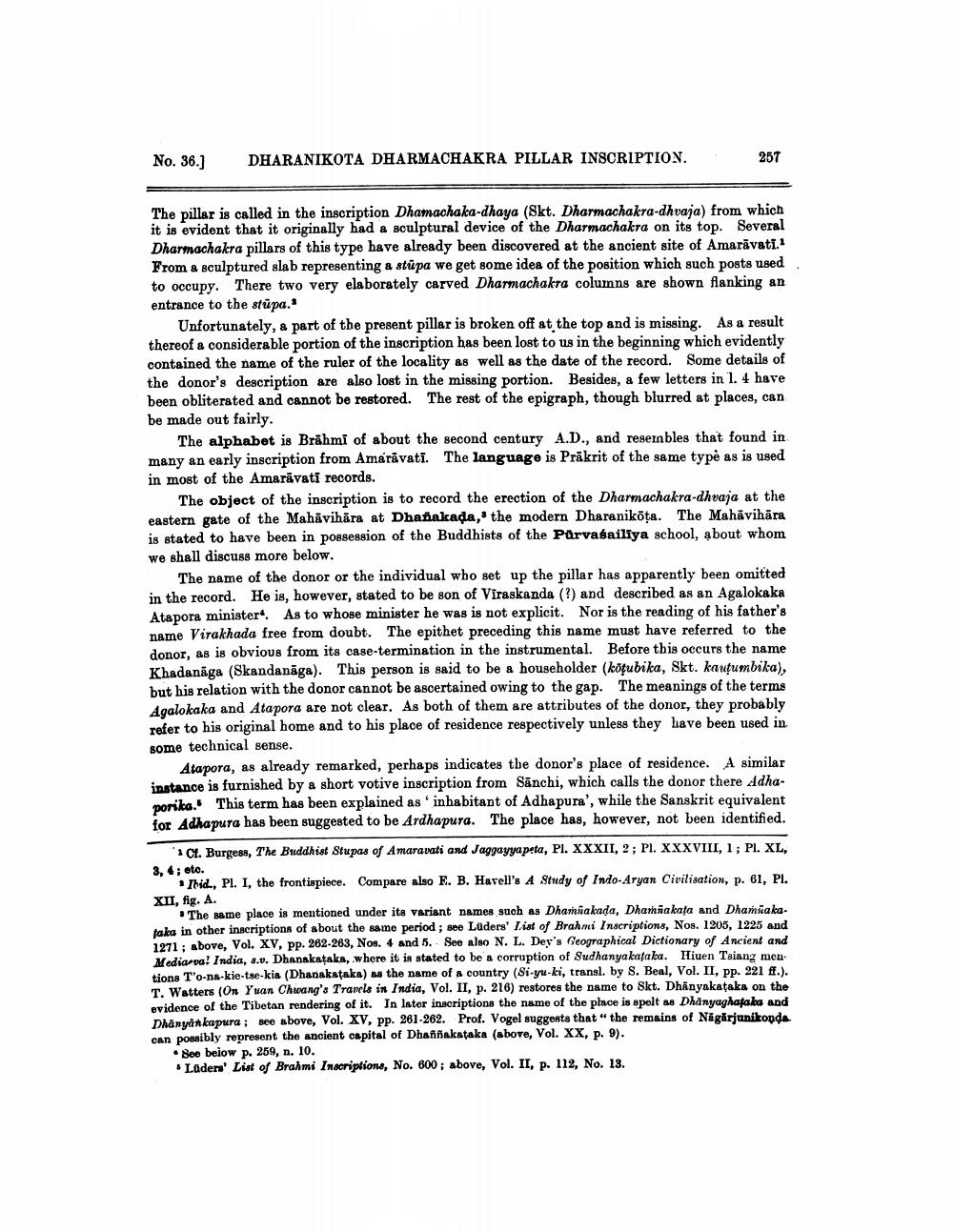________________
No. 36.]
DHARANIKOTA DHARMACHAKRA PILLAR INSCRIPTION.
257
The pillar is called in the inscription Dhamachaka-dhaya (Skt. Dharmachakra-dhvaja) from which it is evident that it originally had a sculptural device of the Dharmachakra on its top. Several Dharmachakra pillars of this type have already been discovered at the ancient site of Amarāvati. From a sculptured slab representing a stupa we get some idea of the position which such posts used to occupy. There two very elaborately carved Dharmachakra columns are shown flanking an entrance to the stūpa."
Unfortunately, a part of the present pillar is broken off at the top and is missing. As a result thereof a considerable portion of the inscription has been lost to us in the beginning which evidently contained the name of the ruler of the locality as well as the date of the record. Some details of the donor's description are also lost in the missing portion. Besides, a few letters in l. 4 have been obliterated and cannot be restored. The rest of the epigraph, though blurred at places, can be made out fairly.
The alphabet is Brahmi of about the second century A.D., and reserables that found in many an early inscription from Amaravati. The language is Prakrit of the same type as is used in most of the Amarāvati records.
The object of the inscription is to record the erection of the Dharmachakra-dhvaja at the eastern gate of the Mahävihāra at Dhanakada," the modern Dharaniköța. The Mahavihāra is stated to have been in possession of the Buddhists of the Purvasailīya school, about whom we shall discuss more below.
The name of the donor or the individual who set up the pillar has apparently been omitted in the record. He is, however, stated to be son of Viraskanda (?) and described as an Agalokaka Atapora minister. As to whose minister he was is not explicit. Nor is the reading of his father's name Virakhada free from doubt. The epithet preceding this name must have referred to the donor, as is obvious from its case-termination in the instrumental. Before this occurs the name Khadanaga (Skandanāga). This person is said to be a householder (köţubika, Skt. kautumbika), but his relation with the donor cannot be ascertained owing to the gap. The meanings of the terms Agalokaka and Atapora are not clear. As both of them are attributes of the donor, they probably refer to his original home and to his place of residence respectively unless they have been used in some technical sense.
Atapora, as already remarked, perhaps indicates the donor's place of residence. A similar instance is furnished by a short votive inscription from Sanchi, which calls the donor there Adhaporika. This term has been explained as 'inhabitant of Adhapura', while the Sanskrit equivalent for Adhapura has been suggested to be Ardhapura. The place has, however, not been identified.
'* CH. Burgess, The Buddhist Stupas of Amaravati and Jaggayyapeta, Pl. XXXII, 2 ; Pl. XXXVIII, 1 ; Pl. XL, 3, 4; eto.
Thid, Pl. I, the frontispiece. Compare also E. B. Harell's A Study of Indo-Aryan Civilisation, p. 61, PI. XII, fig. A.
The same place is mentioned under its variant names such as Dhannakada, Dhamakata and Dhamakataka in other inscriptions of about the same period; see Lüders' List of Brahmi Inscriptions, Nos. 1205, 1225 and 1271; above, Vol. XV, pp. 262-263, Nos. 4 and 5. See also N. L. Dey's Geographical Dictionary of Ancient and Media-va! India, 8.v. Dhanakataka,.where it is stated to be a corruption of Sudhanya kataka. Hiuen Tsiang men. tions T'o-na-kie-tse-kia (Dhanakataka) as the name of a country (Si-yu-ki, transl. by S. Beal, Vol. II, pp. 221 ff.). T. Watters (On Yuan Chwang's Travels in India, Vol. II, p. 216) restores the name to Skt. Dhānyakataka on the evidence of the Tibetan rendering of it. In later inscriptions the name of the place is spelt as Dhanyaghagaba and Dhanyan kapura ; see above, Vol. XV, pp. 261-262. Prof. Vogel suggests that “the remains of Nāgärjanikonda can possibly represent the ancient capital of Dhaññakstaka (above, Vol. XX, p. 9).
• See below p. 259, n. 10. . Lüders' List of Brahmi Inscriptions, No. 600; above, Vol. II, p. 112, No. 13.




